
The museum shop at Frogner offers a large selection of literature related to Oslo, art and design products, traditional games and toys, gifts, and products related to current exhibitions.

The Museum of Oslo is beautifully located at Frogner Manor in the Frogner park, together with the Theatre Museum. Here, you can familiarize yourself with the history behind today’s diverse city.
Experience a variation of exhibitions about Oslo’s history, urban development, the city’s inhabitants, and current issues facing the Oslo of today. You can also visit our pleasant café and gift shop.
Tuesday and Wednesday: 11am–4pm
Thursday: 11am–6pm
Friday, Saturday and Sunday: 11am–4pm
Adults: NOK 120,-
Students: NOK 60,-
Children and youth (under 26): Free admission
Free admission for everyone on the first Thursday of the month.
Tickets include entrance to the Museum of Oslo and the Theatre Museum.
Address: Halvdan Svartes gate 58, 0266 Oslo
Take tram 12 or bus 20 to Frogner plass, or all subway lines to Majorstuen
Wifi
Free wifi available to all guests.
Audio guide
Download our free audio guide in the app “Useeum”. Feel free to bring your own headphones.
Cloakroom
A cloakroom with lockers for coats, bags and other belongings is available to guests.
Accessibility
The museum and the exhibitions are accessible through elevator and/or step-free access. Wheelchairs are available to borrow during your visit. Accessible toilet available.
Babies and small children
Strollers can be parked in the courtyard outside the museum entrance. Baby changing facilities are available. Strollers for use in the exhibition can be borrowed during your visit.

The museum shop at Frogner offers a large selection of literature related to Oslo, art and design products, traditional games and toys, gifts, and products related to current exhibitions.

The pleasant café located at the Museum of Oslo and the Theatre Museum invites you to enjoy coffee, pastries, and light lunches. Seating area in the beautiful courtyard of Frogner manor during the warm months. Oslo Museum café is run by SULT.

Life in Oslo in the 1920s: technological innovation, jazz, dance, and women’s liberation – but also social inequality, poor housing conditions, and political strife.

In August 1624, large parts of the old city of Oslo were reduced to ashes. Get to know the new city that emerged.

Oslo's history through 1,000 years, from the Middle Ages to the present day.